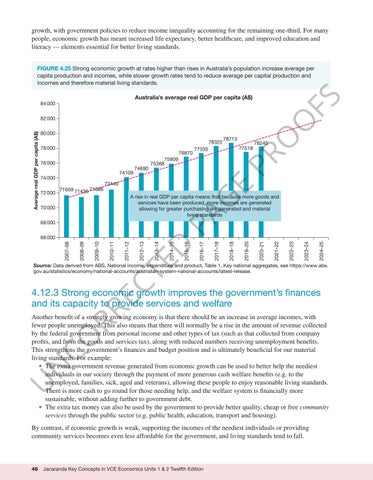“c04EconomicActivity_PrintPDF” — 2022/5/28 — 13:00 — page 48 — #48
growth, with government policies to reduce income inequality accounting for the remaining one-third. For many people, economic growth has meant increased life expectancy, better healthcare, and improved education and literacy — elements essential for better living standards. FIGURE 4.25 Strong economic growth at rates higher than rises in Australia’s population increase average per capita production and incomes, while slower growth rates tend to reduce average per capital production and incomes and therefore material living standards.
FS
Australia’s average real GDP per capita (A$) 84 000
O 78322 76870 75909 75388
76 000 74109
74690
74 000
E
72440 71659 71436 71686
G
A rise in real GDP per capita means that because more goods and services have been produced, more incomes are generated allowing for greater purchasing are generated and material living standards
2024–25
2023–24
2022–23
2021–22
2020–21
2019–20
2018–18
D
2013–14
TE
2012–13
2011–12
2010–11
2009–10
2008–09
2007–08
66 000
2017–18
68 000
2016–17
PA
70 000
2015–16
72 000
78245 77518
77335
PR
78 000
78713
O
80 000
2014–15
Average real GDP per capita (A$)
82 000
CO RR EC
Source: Data derived from ABS, National income, expenditure and product, Table 1, Key national aggregates, see https://www.abs. gov.au/statistics/economy/national-accounts/australian-system-national-accounts/latest-release.
4.12.3 Strong economic growth improves the government’s finances and its capacity to provide services and welfare
U
N
Another benefit of a strongly growing economy is that there should be an increase in average incomes, with fewer people unemployed. This also means that there will normally be a rise in the amount of revenue collected by the federal government from personal income and other types of tax (such as that collected from company profits, and from the goods and services tax), along with reduced numbers receiving unemployment benefits. This strengthens the government’s finances and budget position and is ultimately beneficial for our material living standards. For example: • The extra government revenue generated from economic growth can be used to better help the neediest individuals in our society through the payment of more generous cash welfare benefits (e.g. to the unemployed, families, sick, aged and veterans), allowing these people to enjoy reasonable living standards. There is more cash to go round for those needing help, and the welfare system is financially more sustainable, without adding further to government debt. • The extra tax money can also be used by the government to provide better quality, cheap or free community services through the public sector (e.g. public health, education, transport and housing). By contrast, if economic growth is weak, supporting the incomes of the neediest individuals or providing community services becomes even less affordable for the government, and living standards tend to fall.
48
Jacaranda Key Concepts in VCE Economics Units 1 & 2 Twelfth Edition





















































